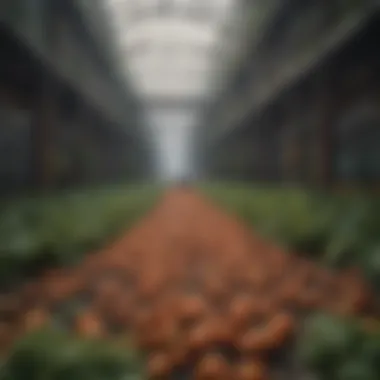Industrialized Food Production: An In-Depth Examination


Article Overview
Purpose of the Article
This article aims to provide a detailed analysis of industrialized food production. It will discuss the processes involved, historical developments, and the implications this production model has on society and the environment. By examining these factors, the article serves to inform readers about the complexities surrounding the efficient production of food at a large scale.
Relevance to Multiple Disciplines
Industrialized food production intersects various fields including agriculture, economics, environmental science, and ethics. Understanding its impact must utilize a cross-disciplinary approach. This article intends to appeal to students, researchers, educators, and professionals by presenting comprehensive insights into food systems.
Research Background
Historical Context
The roots of industrialized food production trace back to the Agricultural Revolution. The introduction of farming techniques and tools allowed for greater efficiency in food cultivation. Over time, these processes evolved with technological advancements, leading to the establishment of agribusiness practices in the 20th century. This marked a significant turning point, as food production began operating at an unprecedented scale.
Key Concepts and Definitions
To understand industrialized food production, a few important concepts must be highlighted.
- Industrial Agriculture: Refers to the large-scale production of food using modern machinery, fertilizers, and pesticides.
- Food Security: The availability of food and one’s access to it. Industrialized production aims to enhance food security, yet raises questions about sustainability.
- Sustainability: The balance between meeting current food needs and preserving the environment for future generations.
- Agroecology: A farming approach that integrates ecological principles, focusing on sustainable agricultural practices.
"The transition from traditional farming to industrialized agriculture has drastically changed the landscape of food production, but not without consequences".
"The transition from traditional farming to industrialized agriculture has drastically changed the landscape of food production, but not without consequences".
Understanding these concepts will facilitate a deeper awareness of the implications of industrialized food production. Each aspect plays a pivotal role in the ongoing discussion about food systems and sustainability. This exploration leads to examining various processes and technologies that characterize industrialized food production.
Prologue
Industrialized food production has revolutionized the way we cultivate, process, and distribute food. Understanding this topic is essential, as it plays a crucial role in addressing contemporary challenges such as food security, environmental sustainability, and economic viability.
First, let’s consider that industrialized food production reflects a transition from traditional farming methods to large-scale, mechanized processes. This shift has allowed for greater efficiency in terms of output per acre and, at the same time, reduced labor costs. However, there are implications that go beyond mere efficiency. These include ecological impacts, shifts in market dynamics, and changes in consumer behavior.
Moreover, insights into industrialized food production help reveal the complexities surrounding global food systems. For instance, the rise of technological innovations can enhance productivity but also raise ethical questions about genetic modification and sustainability. Understanding these factors provides a more nuanced perspective, which is imperative for stakeholders across the spectrum—from policymakers to consumers.
"The evolution of food production illustrates the interconnections between agriculture, economy, and health."
"The evolution of food production illustrates the interconnections between agriculture, economy, and health."
In summary, the significance of industrialized food production lies not just in its capacity to feed billions, but in its lasting effects on society and the environment. By dissecting the past, exploring current trends, and forecasting potential futures, this article aims to give readers a comprehensive understanding of industrialized agriculture's scope and implications.
Historical Context of Food Production
Understanding the historical context of food production is crucial for comprehending the evolution of our current agricultural systems. This section will focus on significant milestones that have shaped food production and the broader implications of these developments. By examining the past, we can better analyze the present landscape and its challenges, along with potential future directions.
Agricultural Revolution
The Agricultural Revolution marks a pivotal transition in human history. It began around 10,000 years ago when societies shifted from nomadic lifestyles to settled farming communities. This transformation was not merely about growing food; it drastically altered social structures and economic systems. Farming allowed for surplus production, which in turn enabled population growth and the establishment of complex societies.
Different regions, such as Mesopotamia, Mesoamerica, and the Indus Valley, experienced unique agricultural practices, adapting to their local environments. The domestication of crops like wheat and rice was particularly significant. As communities adopted farming, they developed new tools and techniques, setting the stage for future advancements.
Technological Advancements
Technological innovations have propelled food production forward across centuries. The invention of the plow, for instance, increased agricultural efficiency. In the 18th century, the introduction of crop rotation and selective breeding significantly improved yields. The mechanization of farming in the 19th and 20th centuries transformed agriculture. Tractors and other machinery reduced the need for manual labor and increased production capacity.
Additionally, modern technology brought about unprecedented advances in food processing and preservation. Refrigeration, canning, and transportation improvements have expanded access to various foods across regions. Today’s precision farming techniques, which utilize data analysis and satellite imagery, have further enhanced agricultural productivity and resource management.
Industrialization Trends
The industrialization of food production began in the late 19th century and intensified in the 20th century. This period saw the emergence of large-scale agricultural enterprises driven by the principles of mass production. Industrialized agriculture enabled the production of food on an unprecedented scale, leading to greater availability and lower prices. However, this trend also led to significant changes in rural landscapes and communities.
The rise of agribusiness has resulted in the consolidation of farms and a focus on a few staple crops, often at the expense of biodiversity. This shift has economic implications, as smaller farmers struggle to compete with large corporations. Furthermore, the reliance on chemical inputs and genetically modified organisms raises ethical questions about sustainability and health impacts.
In summary, the historical context of food production reveals the intricate web of developments that have shaped the modern agricultural landscape. The Agricultural Revolution laid the groundwork for settlement and farming, while subsequent technological advancements and industrialization trends have transformed food production. Understanding these historical elements is essential for addressing current challenges and envisioning sustainable futures in agriculture.
Mechanization in Agriculture
Mechanization in agriculture represents a crucial development in the evolution of food production. It provides significant advancements that have transformed farming practices over the years. This transformation is not just about using machines; it encompasses a complete shift in the way agriculture operates.
An essential aspect is the development of machinery. Tractors, combine harvesters, and planters have revolutionized traditional farming. These machines are designed to automate labor-intensive tasks, increasing the speed and consistency of agricultural operations. The introduction of machinery has made it possible to cultivate larger areas of land with fewer human resources.
Development of Machinery
Developing machinery in agriculture has a profound history. Early innovations included the seed drill, invented by Jethro Tull in the early 18th century. This tool enabled more efficient planting, helping increase crop yields. In the 20th century, the advent of tractors allowed for various tasks, such as plowing, tilling, and harvesting. This machinery has advanced significantly with the integration of computer technology. Today, GPS systems guide farming equipment, improving accuracy and efficiency. The mechanization of agriculture has drastically reduced the amount of time needed for planting and harvesting.
Impact on Labor
Despite the benefits of mechanization, the impact on labor cannot be overlooked. The automation of several farming tasks leads to a decrease in the need for manual labor. While this transition can enhance productivity, it raises serious concerns about employment in the agricultural sector. Many rural communities are experiencing job losses due to this shift. As machines take over roles once held by people, re-skilling is essential to prepare the labor force for new opportunities. Farmers must consider both the financial implications and the effect on local communities.
Efficiency and Production Rates
Mechanization significantly boosts efficiency and production rates in agriculture. With machinery handling tasks that were once manual, farms can operate much faster. As a result, crop production has increased dramatically. For example, the use of combine harvesters allows for the swift collection of grains in a fraction of the time it would take to do so manually. Enhanced efficiency also means that farmers can produce more food in less time, supporting a growing global population.
In summary, mechanization in agriculture is essential for understanding industrialized food production. The development of machinery showcases how technology can facilitate larger scale operations. However, the labor implications and efficiency gains present challenges and opportunities that require careful consideration.
Chemical Inputs and Biotechnology
Chemical inputs and biotechnology are central themes in the exploration of industrialized food production. These aspects are crucial for enhancing crop yields, ensuring food security, and maintaining the sustainability of farming practices. Understanding the intricacies of these elements can shed light on the benefits and challenges associated with modern agricultural practices.
Synthetic Fertilizers
Synthetic fertilizers are chemical compounds created to augment soil nutrient levels. They typically contain essential nutrients like nitrogen, phosphorus, and potassium. These fertilizers have played a significant role in the increase of agricultural productivity since the mid-20th century. They enable farmers to obtain higher yields per acre, which is necessary to feed a growing global population.


While using synthetic fertilizers can support food production, it is not without downsides. Excessive application can result in nutrient runoff, contaminating waterways and harming aquatic ecosystems. Furthermore, long-term reliance on chemical fertilizers may degrade soil health, reducing its natural fertility over time. Thus, a balance must be struck between using synthetic fertilizers and adopting more sustainable practices, such as organic amendments or crop rotation, which can help maintain soil integrity.
Pesticides and Herbicides
Pesticides and herbicides are chemicals designed to protect crops from pests and weeds. Their widespread use in industrial agriculture has significantly reduced crop losses and improved efficiency. These substances are essential, especially in large-scale production, where the risk of infestation can be high due to monoculture practices.
However, the implications of pesticide use extend beyond immediate agricultural benefits. Non-target species, including beneficial insects and wildlife, can be adversely affected, leading to biodiversity loss. Furthermore, there are growing concerns regarding pesticide residues on food products and their potential impacts on human health. Regulatory measures exist to minimize these risks, but ongoing research into integrated pest management (IPM) practices aims to reduce reliance on chemical solutions in favor of more natural alternatives.
Genetic Modification
Genetic modification involves altering the DNA of organisms to achieve desired traits. In agriculture, this technology allows for the creation of crops that are resistant to pests, diseases, and environmental stressors. For instance, Bt corn is engineered to produce a protein toxic to specific insects, reducing the need for chemical insecticides.
Despite the benefits, genetic modification is sometimes met with public skepticism. Concerns about food safety, the potential for allergenicity, and ethical considerations surrounding genetically modified organisms (GMOs) often dominate discussions. Regulatory frameworks are in place to ensure GMOs undergo extensive testing before being released into the market. Furthermore, labeling initiatives are increasing transparency, allowing consumers to make informed choices.
In summary, chemical inputs and biotechnology represent a double-edged sword in industrial food production. They have greatly contributed to the advancement of agriculture, yet pose significant challenges that require critical evaluation and management. As the conversation around sustainable practices continues to evolve, it is essential to consider how these technologies can be employed in a way that supports both productivity and ecological health.
Economic Implications of Industrialized Food Production
The economic implications of industrialized food production are profound and far-reaching. This aspect holds particular significance as it shapes not only the agricultural sector but also influences global economics, local communities, and consumer behavior. By understanding these implications, we can grasp the benefits and considerations that come with this mode of food production. The strategies behind industrialized farming impact various areas including trade dynamics, market structures, and the economic vitality of local economies.
Global Trade Dynamics
Global trade dynamics represent one of the pillars of industrialized food production. The advancements in agricultural technology and infrastructure have facilitated international trade in food products. Countries with surplus production export their goods to those with deficits. For example, nations like the United States and Brazil dominate the export of soybeans and corn, affecting global supply chains.
However, this trade is influenced by several factors:
- Market Access Restrictions: Tariffs and trade agreements can significantly affect the competitiveness of food products.
- Supply Chain Optimization: Efficient logistics is critical to maintaining freshness and quality in food products.
- Emerging Markets: As economies grow, their food demand increases, reshaping trade patterns.
This interconnectedness can create opportunities, but it can also lead to vulnerabilities in times of crisis, such as pandemics or geopolitical tensions.
Market Monopolies
The rise of industrialized food production has led to the concentration of market power, resulting in monopolistic practices. A few corporations dominate significant segments of the agricultural supply chain, from seed production to processing. For example, Bayer and Monsanto, now part of the same company, have a substantial share of the global seed market.
Key concerns surrounding market monopolies include:
- Reduced Competition: When a few firms control the market, competition diminishes, potentially leading to higher prices for consumers.
- Innovation Stifling: Smaller companies may struggle to compete, which can hinder innovation in agricultural practices.
- Dependency Risks: Farmers may become overly dependent on a few suppliers for seeds and chemicals, affecting their autonomy.
This concentration can have serious implications for sustainability and pricing structures within the food industry.
Impact on Local Economies
Local economies are deeply affected by the practices of industrialized food production. While large-scale farming might boost employment in some regions, it can also lead to detrimental effects on smaller farming communities. The following aspects illustrate this impact:
- Job Displacement: Mechanization and efficiency measures can lead to job losses, as machines replace manual labor.
- Price Pressure: Local farmers may struggle to compete with cheaper, mass-produced goods, affecting their profitability.
- Community Viability: Areas relying heavily on agriculture may see demographic shifts as younger generations leave for urban opportunities.
While industrialized agriculture can lead to lower prices for consumers, the underlying costs to local economies and communities need careful consideration.
Understanding the economic implications of industrialized food production is crucial in navigating its future trajectory.
Understanding the economic implications of industrialized food production is crucial in navigating its future trajectory.
Food Security and Access
Food security is a critical facet in the context of industrialized food production. As the world’s population grows rapidly, the ability to produce, distribute, and access food becomes increasingly essential. The concept broadly encompasses the availability of food, its accessibility to people, and its utilization to ensure proper nutritional intake. Efficient food production systems are necessary to address these components, which are interconnected and influence each other.
Feeding the Global Population
Feeding the global population poses a significant challenge in the face of increasing demand. Current projections estimate that the global population may reach nearly 10 billion by 2050. This raises the need to boost food production by roughly 70%. To meet this challenge, many strategies are employed, including the optimization of crop yields through advanced agricultural practices. The use of high-yield varieties, precision farming, and large-scale mechanization are common strategies in industrialized agriculture.
Access to technology also plays a vital role. Areas with limited access to resources may struggle to implement these practices, leading to disparities in food availability. As such, global collaboration becomes vital in ensuring that innovative practices in food production are accessible to all nations.
Food Distribution Challenges
Food distribution remains one of the most formidable challenges in achieving food security. Despite sufficient food production capacity, inefficiencies in distribution can lead to substantial waste and shortages. It is estimated that over one-third of all food produced globally goes to waste. Factors contributing to this challenge include logistical inefficiencies, inadequate infrastructure, and lack of effective supply chains.
Urbanization and climate change further complicate the distribution landscape. Rapid urban growth increases the pressure on food supply systems to provide fresh and nutritious food in urban centers, often at higher costs.
Nutritional Quality Concerns
While industrialized food production aims to increase quantity, it often raises questions about the nutritional quality of the food produced. High-yield farming techniques may prioritize output over the nutrient density of crops. This can result in a decrease in essential vitamins and minerals in the food supply.
Consumers are increasingly aware of these concerns, leading to a rise in demand for organic and nutrient-rich food options. However, accessibility to high-quality food can be limited by economic factors as well as geographic barriers. This creates a complex cycle where the availability of affordable, nutrient-rich food is necessary for improving public health outcomes.
"Food security is more than just a measure of supply; it encompasses the quality and accessibility of food to every individual."
"Food security is more than just a measure of supply; it encompasses the quality and accessibility of food to every individual."
Addressing food security and access is not just about increasing production, but also about ensuring that food systems are inclusive, sustainable, and capable of meeting diverse dietary needs.
Environmental Impact of Industrialized Agriculture
The environmental impact of industrialized agriculture is a critical area of examination in understanding contemporary food production systems. It shapes the landscape of agriculture and its interconnectedness with ecological health. This section unfolds the multifaceted consequences of large-scale farming practices, emphasizing the pressing need for awareness and change. By analyzing soil degradation, water resource management, and biodiversity loss, we can gain insights into the sustainability challenges inherent in current agricultural practices.
Soil Degradation
Soil degradation arises as one of the most pressing issues linked to industrialized agriculture. Through practices such as monocropping and excessive use of chemical inputs, soil quality deteriorates over time. This results in reduced fertility, lower crop yields, and increased vulnerability to erosion.
- Monocropping: The focus on planting a single crop can lead to nutrient depletion. Diverse cropping systems are essential for maintaining soil health.
- Chemical Inputs: High reliance on synthetic fertilizers often disrupts natural soil biology, hindering nutrient cycles.
- Erosion: Continuous tillage breaks down soil structure, making it more prone to erosion by wind and water.
The long-term consequences are alarming. As soil loses its capacity to support agricultural activities, food security becomes compromised, emphasizing the need for sustainable practices that restore soil health.
Water Resource Management
Water resource management presents another significant challenge in the realm of industrialized agriculture. The demand for water has escalated with the intensification of farming practices, leading to over-extraction of water sources. It is crucial to recognize the disparities this creates among various communities and ecological systems.


- Over-Irrigation: Excessive irrigation practices lead to waterlogging and salinization, negatively impacting crop production.
- Aquifer Depletion: Intensive farming often causes aquifers to be drained faster than they can be replenished, threatening long-term water availability.
- Pollution: Substantial runoff from fertilizers and pesticides contributes to water pollution, affecting coastal and freshwater ecosystems.
Effective management strategies are necessary to tackle this growing crisis. Conservation techniques and rainwater harvesting can provide more sustainable alternatives that balance agricultural needs with environmental constraints.
Biodiversity Loss
Biodiversity loss is an often overlooked yet significant consequence of industrialized agriculture. The shift towards uniformity in crop production reduces genetic diversity within agriculture, making ecosystems less resilient to diseases and climate changes.
- Habitats Destruction: Expansion of agricultural lands leads to habitat destruction, displacing numerous species.
- Pesticide Usage: The heavy application of pesticides not only impacts target pests but also threatens non-target species, including beneficial insects and pollinators.
- Genetic Homogeneity: Relying on a narrow range of crop varieties limits adaptive capacity and resilience of both crops and the ecosystems they inhabit.
The decline in biodiversity is concerning. It diminishes ecosystem services essential for food production, such as pollination and pest control. Protecting biodiversity necessitates a shift in agricultural practices to embrace ecological approaches that promote variety and resilience.
The sustainability of agricultural systems is heavily influenced by the environmental costs of industrialized practices. Without intervention, these impacts could jeopardize food security and ecological balance globally.
The sustainability of agricultural systems is heavily influenced by the environmental costs of industrialized practices. Without intervention, these impacts could jeopardize food security and ecological balance globally.
Addressing these issues requires a comprehensive understanding of how agricultural practices influence the environment. This insight is essential for developing strategies that promote sustainable food systems, balancing production needs with ecological health.
Social and Ethical Considerations
The realm of industrialized food production is not just a matter of efficiency and technology; it encompasses significant social and ethical considerations. Understanding these elements is crucial for evaluating the overall impact of industrialized systems on society and the environment. This section delves into various aspects, particularly focusing on animal welfare, worker rights, and cultural impacts, highlighting how these factors intertwine with sustainability and ethical consumption.
Animal Welfare Concerns
Animal welfare stands as a pivotal concern within the industrialized food production framework. Intensive farming practices often prioritize maximum output with minimal costs, which can lead to dire consequences for livestock. Animals raised in confined conditions, such as in factory farms, frequently experience stress, overcrowding, and limited access to natural behaviors. The ethical implications are profound, prompting a growing demand for humane treatment standards.
There are movements, like the Humane Society and various animal rights organizations, advocating for better practices. They emphasize the need for transparency in supply chains. Consumers are becoming more aware and selective, sometimes favoring brands that prioritize animal welfare. In response, some producers have started to adopt more humane practices, indicating a shift in industry standards. Ensuring animal welfare is not just an ethical issue but also a potential market differentiator that can enhance brand loyalty and appeal to conscious consumers.
Worker Rights and Conditions
Worker rights in the agricultural sector are often overlooked amidst the discussion of technological advancements and productivity. The industrialized food production system can create a challenging work environment, especially for migrant and seasonal laborers. Issues such as low wages, long hours, and limited access to healthcare are common. Additionally, workers may face hazardous conditions, which raise significant ethical red flags.
Organizations advocating for fair labor practices have begun to address these concerns by promoting better conditions and wages. Policies supporting worker rights can lead to improved labor relations and productivity. Moreover, ethical treatment of workers is integral to creating a sustainable food system that ensures longevity and stability in production. Recognizing worker contributions is vital for fostering a sense of dignity and respect within the industry.
Cultural Impacts of Food Production
The cultural ramifications of industrialized food production should not be underestimated. Food is deeply interconnected with cultural identity and heritage. The shift to monoculture and standardized products can lead to a loss of traditional farming practices and local cuisines. As global food systems become more homogenized, unique culinary traditions risk fading into obscurity.
Mass production often displaces small-scale farmers, impacting local economies and community ties. The loss of cultural diversity within food systems can result in a diminished sense of community and belonging. However, awareness of these issues is prompting a revival of interest in local, organic, and heritage foods. Consumers are increasingly looking for ways to reconnect with food sources that reflect their cultural values. This change indicates a broader recognition of the need to incorporate cultural perspectives into discussions about food production.
The relationship between food production and social values is intricate, emphasizing the importance of addressing ethical considerations in industrialized agriculture.
The relationship between food production and social values is intricate, emphasizing the importance of addressing ethical considerations in industrialized agriculture.
As society continues to grapple with the complexities of industrialized food production, it becomes clear that social and ethical considerations are not peripheral; they are central to discussions about sustainability and responsibility in how we produce and consume food.
Future Directions in Food Production
The future of food production is of great importance as we face an array of challenges, including climate change, population growth, and declining natural resources. The direction we choose to take with our food systems can significantly affect global food security, ecological sustainability, and health outcomes. Understanding the future trends in food production can lead to innovative methods and practices that can help mitigate existing issues. This section will delve into sustainable agriculture practices, regenerative agricultural techniques, and technological innovations in food systems, providing insight into how these elements can shape the future of food production.
Sustainable Agriculture Practices
Sustainable agriculture is a crucial component of modern food systems, focusing on methods that enable food production without exhausting resources or harming the environment. Key principles include environmental stewardship, economic viability, and social equity.
Some important examples and practices within sustainable agriculture are:
- Crop rotation: This involves alternating the types of crops grown in a particular area to improve soil health and reduce pest cycles.
- Agroforestry: The integration of trees and shrubs into farming systems, which can enhance biodiversity and improve land productivity.
- Organic farming: Utilizing natural processes and materials while avoiding synthetic chemicals and genetically modified organisms.
The benefits of these practices extend beyond environmental impacts. Sustainable agriculture can enhance community resilience and ensure long-term food security. Promoting biodiversity through varied farming systems can also lead to healthier ecosystems, which in return supports better agricultural outputs.
Regenerative Agricultural Techniques
Regenerative agriculture goes beyond sustainability by actively improving and regenerating soil health, ecosystems, and biodiversity. This approach emphasizes practices that restore and maintain the natural processes, focusing on long-term ecological health rather than merely mitigating harm.
Key regenerative techniques include:
- Cover cropping: Planting crops to cover the soil rather than leaving it bare, which can prevent erosion, improve soil structure, and increase organic matter.
- Reduced tillage: Minimizing soil disturbance can enhance soil biology, promote carbon sequestration, and improve water retention.
- Holistic grazing management: Using livestock in a way that mimics natural grazing patterns. This technique can improve soil health and biodiversity while contributing to carbon absorption.
Implementing these regenerative techniques can lead to more resilient food systems capable of adapting to changing climatic conditions. Regeneration not only seeks to maintain agricultural outputs but also aims to enhance the ecological balance, thereby supporting the environment as it supports human agriculture.
Technological Innovation in Food Systems
Technological innovation holds significant potential to transform food production for the better. Advancements in technology can directly address many existing challenges, making food systems more efficient, equitable, and environmentally friendly. Some promising areas of technological innovation include:
- Precision agriculture: Using GPS and data analytics to enhance crop management, optimize resource use, and minimize waste.
- Vertical farming: A method of growing crops in stacked layers or vertically inclined surfaces, allowing for urban agricultural practices that can reduce the need for transportation and conserve land space used for farming.
- Biotechnology: Advances in genetic engineering can lead to crops that are more resilient to pests, diseases, and changing climates, ultimately boosting production.
Moreover, emerging technologies like machine learning and Internet of Things (IoT) can help farmers make data-driven decisions, optimizing yield and reducing costs.
"Investing in technological advancements is necessary to build a sustainable future in food production."
"Investing in technological advancements is necessary to build a sustainable future in food production."
Case Studies in Industrialized Food Production
Case studies serve as a crucial instrument in understanding the real-world applications and consequences of industrialized food production. They allow researchers, educators, and students to examine specific instances of agricultural practices, providing insight into both successes and failures. By analyzing these cases, we gain a more nuanced view of the larger food production landscape, including its economic, social, and environmental ramifications. The examination of case studies can highlight successful innovations, reveal system failures, and project potential growth areas in emerging markets. This makes them particularly relevant in the context of current discussions on sustainability and food security.
Success Stories
Success stories in industrialized food production showcase how certain approaches and technologies can lead to enhanced productivity, decreased waste, and improved food quality. One notable example is the case of the Green Revolution, which began in the mid-20th century. This movement introduced high-yield variety seeds, synthetic fertilizers, and advanced irrigation techniques across developing nations. Countries like India and Mexico benefitted immensely from these practices, achieving significant increases in staple crops like wheat and rice. The administration of these technologies not only alleviated hunger but also contributed to economic growth through increased agricultural exports.
Another success story can be found in vertical farming, where crops are grown in stacked layers using controlled-environment agriculture. Companies like AeroFarms in the United States have demonstrated that vertical farming can produce crops with up to 95% less water than traditional farming. This model addresses urban food deserts and reduces transportation emissions, providing fresh produce to urban centers.
"Successful case studies illustrate the potential of technology and innovation to transform food systems for better yields and sustainability."
"Successful case studies illustrate the potential of technology and innovation to transform food systems for better yields and sustainability."


Failures and Lessons Learned
Failures in industrialized food production can be just as instructive as success stories. The case of Monsanto's Bt cotton in India illustrates the complexities surrounding genetic modification. While initially promising, the rollout faced numerous challenges, leading to significant financial strain on farmers. The dependency on a single crop variety caused ecological harm and a decrease in biodiversity, revealing the risks associated with monocultures. These issues raised ethical questions about the fairness and sustainability of relying too heavily on biotechnology.
Moreover, the collapse of the Beef Industry in Europe due to BSE (Bovine Spongiform Encephalopathy) crisis highlighted the dangers of industrialized farming approaches. The rapid production methods aimed at maximizing beef output led to unsafe practices. Resulting public health concerns prompted widespread regulations and a decline in consumer trust. Follow-up studies emphasized the need for stricter safety measures and monitoring.
Emerging Markets
Emerging markets represent an important frontier for industrialized food production. Countries experiencing economic growth, like Brazil and Vietnam, are expanding their agricultural sectors through the adoption of new food technologies. In Brazil, the incorporation of precision agriculture techniques is revolutionizing crop management. This strategy allows farmers to use resources more efficiently, optimizing yield while minimizing input costs and environmental impact.
In Africa, initiatives like the Alliance for a Green Revolution aim to increase productivity while addressing the unique challenges of local markets. By focusing on sustainable practices and smallholder farmer education, these programs provide adaptable models that other regions can also consider.
Understanding the landscape of emerging markets can reveal potential growth avenues. Various organizations and investors are focusing on integrating technology with traditional practices to develop smart farming methodologies. This intersection of innovation and sustainability can ultimately enable these markets to better cope with food security challenges.
Regulatory Frameworks and Policies
Regulatory frameworks and policies play a crucial role in shaping industrialized food production. These regulations help ensure food safety, protect the environment, and manage trade practices in a global marketplace. A nuanced understanding of these elements is important for various stakeholders, including farmers, consumers, policymakers, and researchers. This section examines the major regulatory aspects relevant to food production today.
Food Safety Regulations
Food safety regulations are essential for protecting consumers. These rules govern how food is produced, processed, and marketed. They help prevent foodborne illnesses and ensure that food products meet certain quality standards. Agencies like the U.S. Food and Drug Administration (FDA) and the European Food Safety Authority (EFSA) set these regulations.
Key aspects include:
- Traceability: Producers must be able to track their food products through the supply chain. This helps identify sources of contamination swiftly.
- Standards Compliance: Companies must adhere to specific hygiene and processing standards. This includes ensuring proper storage conditions and preventing cross-contamination.
- Inspections: Regular inspections of food production facilities are conducted to ensure compliance with safety standards.
The impact of these regulations is significant; they help to build consumer confidence and protect public health. Failure to comply can lead to severe penalties for producers.
Environmental Protection Policies
Environmental protection policies are designed to mitigate the ecological impact of industrialized agriculture. Regulations often focus on sustainable practices that minimize pollution, conserve water, and protect biodiversity. For instance, the Clean Water Act in the United States regulates discharges of pollutants into the nation's waters, enforcing limits on fertilizer runoff and other agricultural pollutants.
The benefits of these policies include:
- Sustainable Practices: Encouraging farming methods that do not deplete natural resources.
- Protection of Ecosystems: Preventing harm to local wildlife and habitats by regulating land use.
- Climate Resilience: Promoting practices that enhance the resilience of agricultural systems to climate change, such as crop rotation and cover cropping.
These policies reflect a growing recognition of the interconnectedness of food production and environmental health.
Trade and Tariff Regulations
Trade and tariff regulations govern the import and export of food products. These rules affect pricing, availability, and the competitiveness of domestic versus international products. Such regulations are vital for maintaining a level playing field in agricultural markets and protecting local industries from foreign competition.
Important components include:
- Tariff Rates: These determine how much tax is applied to imported goods, influencing the cost for consumers.
- Quotas: Some policies set limits on the amount of a product that can be imported, sheltering local producers from being outcompeted.
- Trade Agreements: Agreements between countries can facilitate market access but must consider the balance between free trade and the protection of local economies.
By shaping the global trade landscape, these regulations have significant implications for both the economy and food security.
"Effective regulatory frameworks are essential for ensuring the safety and sustainability of food production in a rapidly changing world."
"Effective regulatory frameworks are essential for ensuring the safety and sustainability of food production in a rapidly changing world."
Public Perception and Consumer Behavior
Public perception and consumer behavior play crucial roles in shaping the dynamics of industrialized food production. They reflect and influence the way food production systems are perceived by the society at large. Understanding these aspects is essential as they can push changes in production practices, policy formulation, and consumer habits. Awareness among consumers can lead to increased demand for sustainable food practices, reshaping how food is produced, marketed, and consumed. This section will dissect different components that contribute to public perception and consumer behavior, examining trends, preferences, and the implications of food labeling.
Consumer Awareness Trends
Consumer awareness is increasingly driving changes in the food production landscape. Today, many consumers become vigilant about where their food comes from and how it is produced. This heightened awareness stems from various sources, including documentaries, social media, and news coverage of food safety incidents.
- Sources of Awareness: Consumers gain knowledge through social media platforms, health blogs, and initiatives from environmental organizations.
- Importance of Transparency: Transparency in sourcing and production processes fosters trust. Consumers prefer brands that provide information on their practices and ingredients used.
- Health Concerns: Issues such as obesity and illness linked to industrial food practices lead consumers to seek healthier alternatives. As such trends grow, companies are prompted to adapt their offerings to align with consumer expectations.
Overall, rising consumer awareness not only encourages healthier eating habits but also presses food producers to prioritize sustainable practices.
Organic vs Conventional Food Choices
The clash between organic and conventional food options is a central topic within public perception. Many consumers are faced with the dilemma of choosing between these two. While organic foods are perceived as healthier and more environmentally friendly, their higher costs can deter some consumers.
- Health Perception: Organic food is often believed to be more nutritious. Studies suggest that organic produce may have higher levels of certain nutrients.
- Environmental Benefits: Organic farming practices minimize chemical use, appealing to environmentally-conscious consumers.
- Cost Factor: The price of organic products can be a barrier. Price sensitivity influences consumer choices, compelling a segment to opt for conventional food despite potential concerns.
Understanding these factors can help producers and marketers tailor their approaches to meet consumer preferences more effectively.
Impact of Food Labeling
Food labeling serves as a bridge between producers and consumers. The information displayed on labels can significantly influence purchasing decisions. Consumers are increasingly scrutinizing labels to make informed choices.
- Ingredient Transparency: Clear labeling lets consumers understand what they are consuming. Ingredients like artificial additives and genetically modified organisms are often scrutinized.
- Certifications: Labels indicating organic or fair trade can enhance consumer trust. These certifications provide validation of promised attributes concerning ethics and quality.
- Nutritional Information: Detailed nutritional facts help consumers make healthier decisions, addressing growing health concerns.
In summary, well-structured food labeling can empower consumers, reinforcing their preferences for safer and more sustainable options. It also allows producers to distinguish their products in a competitive market.
"Consumer behavior is more than just buying choices; it reflects our values and beliefs about health, sustainability, and ethics."
"Consumer behavior is more than just buying choices; it reflects our values and beliefs about health, sustainability, and ethics."
The End
Addressing public perception and consumer behavior is essential for understanding current trends in industrialized food production. Rising consumer awareness creates a demand for transparency, drives preferences for organic options, and emphasizes the importance of clear labeling. Moving forward, food producers must take these factors into account to align with evolving consumer expectations.
Closure
The conclusion section of this article serves as a vital synthesis of the multifaceted issues surrounding industrialized food production. Understanding this topic is crucial for multiple reasons. First, it encapsulates the historical trajectory of food production and its transformation into a global industrial model. By tracing back the roots of agricultural practices, we can better grasp the current challenges and opportunities.
Second, the implications for society and the environment cannot be overlooked. With increasing global populations, food security remains a pressing concern. This article highlights the intricate balance between technological advancements and their ecological repercussions. Sustainable practices must be at the forefront of discussions to ensure that future generations inherit a viable food system.
Furthermore, the economic aspects are integral. Global trade dynamics and market monopolies can disproportionately impact local economies. Understanding these relationships equips stakeholders with the knowledge needed to advocate for fair and equitable agricultural practices.
"The sustainability of food production systems is not just an option; it is a necessity for a healthy planet and society."
"The sustainability of food production systems is not just an option; it is a necessity for a healthy planet and society."
Lastly, consumer behavior influences the market landscape. Increased awareness of food origins, ethical considerations, and health implications drives demand for transparency in food production. Recognizing this shift is essential for producers, policymakers, and educators who seek to align practices with consumer values.



